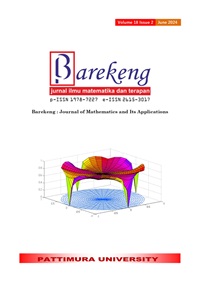MODELLING CRIME RATES IN INDONESIA USING TRUNCATED SPLINE ESTIMATOR
Abstract
Criminal acts are actions that violate the law and can arise from various factors such as emotions, psychological pressure, and others. Crime rate is a number that indicate the level of crime vulnerability in a certain area at a certain time. Higher crime rates correspond to increased vulnerability in an area, and vice versa. Among various forms of criminal acts, the number of criminal acts and narcotics crimes in Indonesia tends to increase in 2020 and 2021. The aim of the research is to identify the characteristics of crime rate data based on the number of decency and narcotics incidents in Indonesia using a nonparametric regression approach. This research uses a nonparametric regression method spline truncated and linear regression as comparison. It was found that West Papua Province has the highest crime rate, based on a comparison between linear regression model and truncated spline nonparametric regression model, it can be concluded that the best model is the truncated spline nonparametric regression model with a Generalized Cross Validation (GCV) of 2468.487 and a coefficient of determination of 0 .7389091, indicating that approximately 73% of the variability of the dependent variable can be explained by the independent variables included in the model.
Downloads
References
Numbeo, “Crime Index by City 2024”, 2024, [Online], Tersedia: https://www.numbeo.com/crime/rankings.jsp [Diakses: 20 Oktober 2023].
Wilona, M., “Representasi Kriminalitas dalam Film Ted dan Ted 2,” Jurnal E-Komunikasi, vol. 3, no. 2, pp. 1-12, 2015.
Badan Pusat Statistik Indonesia, “Statistik Kriminal 2021”, 2022, [Online], Tersedia: https://www.bps.go.id/id/publication/2021/12/15/8d1bc84d2055e99feed39986/statistik-kriminal-2021.html [Diakses pada 16 September 2023].
Syaputra, H., “Tingkat Kejahatan Selama Pandemi”, 2022, [Online], Tersedia: https://news.detik.com/kolom/d-5926380/tingkat-kejahatan-selamapandemi [Diakses pada 16 September 2023].
Zaki, A., and Ilham, M., “Pemodelan Jalur pada Faktor yang Mempengaruhi Kriminalitas di Sulawesi Selatan Tahun 2021,” Jurnal Matematika dan Statistika serta Aplikasinya, vol. 10, no. 1, pp. 1-8, 2022.
Ningsih, D. R., Intan, P. K., and Yuliati, D., “Pemodelan Tindak Pidana Kriminalitas di Kota Tangerang Menggunakan Metode Regresi Lasso,” ESTIMASI: Journal of Statistics and Its Application, pp. 64-77, 2023.
Febrianti, E., Susetyo, B., and Silvianti, P., “Pemodelan Tingkat Kriminalitas di Indonesia Menggunakan Analisis Geographically Weighted Panel Regression,” Xplore: Journal of Statistics, vol. 12, no. 1, pp. 91–109, 2023.
Nurdiani, N., Herrhyanto, N., and Dasari, D., “Regresi Nonparametrik Birespon,” EurekaMatika, vol. 5, no. 1, pp. 106-121, 2017.
Badan Pusat Statistik Indonesia, “Statistik Kriminal 2022,” 2023, [Online], Tersedia: https://www.bps.go.id/id/publication/2022/11/30/4022d3351bf3a05aa6198065/statistik-kriminal-2022.html [Diakses pada 16 September 2023].
Chamidah, N., and Lestari, B., “Analisis Regresi Nonparametrik dengan Perangkat Lunak R,” Airlangga University Press, 2022.
Prasetyo, R. A., and Helma, “Analisis Regresi Linear Berganda Untuk Melihat Faktor yang Berpengaruh Terhadap Kemiskinan di Provinsi Sumatera Barat,” Journal Of Mathematics UNP, vol. 7, no. 2, pp. 62-68, 2022.
Sulistyono, S. and Sulistiyowati, W., “Peramalan Produksi dengan Metode Regresi Linier Berganda,” PROZIMA (Productivity, Optimization and Manufacturing System Engineering), vol. 1, pp. 82, 2018, https://doi.org/10.21070/prozima.v1i2.1350
R. B. Darlington and A. F. Hayes, “Regression analysis and linear models: Concepts, applications, and implementation,” Guilford Publications, 2016.
J. Frost, “Regression Analysis: An Intuitive Guide for Using and Interpreting Linear Models,” Statistics by Jim Publishing, 2019.
S. Hartshorn, “Linear Regression And Correlation: A Beginner’s Guide,” Amazon digital services LLC, 2017.
Pratiwi, L.P.S., Ayuningsih, N.P.M., and Dwijayani, N.M, “Perbandingan GCV dan UBR dalam Regresi Nonparametrik Multivariabel,” Jurnal Matematika, vol. 11, no. 1, pp. 64-74, 2021.
Pratiwi, L.P.S., Ayuningsih, N.P.M., and Wijaya, I.M.P.P., “Perbandingan Metode CV dan GCV pada Pemodelan MARS (Aplikasi Rata-Rata Lama Sekolah di Kabupaten Gianyar),” SAINTIFIK: Jurnal Matematika, Sains dan Pembelajarannya, vol. 8, no. 2, pp. 114-122, 2022.
Abdullah, S.M., and Novianti, W. “Perancangan Sistem Informasi Peramalan Penjualan Meubel menggunakan Metode Moving Average (Studi Kasus Toko Meubel Sumber Rejeki),” INFORMASI INTERAKTIF: Jurnal Informatika dan Teknologi Informasi, vol. 7, no. 2, pp. 96-100, 2022.
Copyright (c) 2024 Nur Chamidah, Azzahra Fania, Diana Ulya, Muhammad Althof Juniar, Rico Ramadhan

This work is licensed under a Creative Commons Attribution-ShareAlike 4.0 International License.
Authors who publish with this Journal agree to the following terms:
- Author retain copyright and grant the journal right of first publication with the work simultaneously licensed under a creative commons attribution license that allow others to share the work within an acknowledgement of the work’s authorship and initial publication of this journal.
- Authors are able to enter into separate, additional contractual arrangement for the non-exclusive distribution of the journal’s published version of the work (e.g. acknowledgement of its initial publication in this journal).
- Authors are permitted and encouraged to post their work online (e.g. in institutional repositories or on their websites) prior to and during the submission process, as it can lead to productive exchanges, as well as earlier and greater citation of published works.






1.gif)



